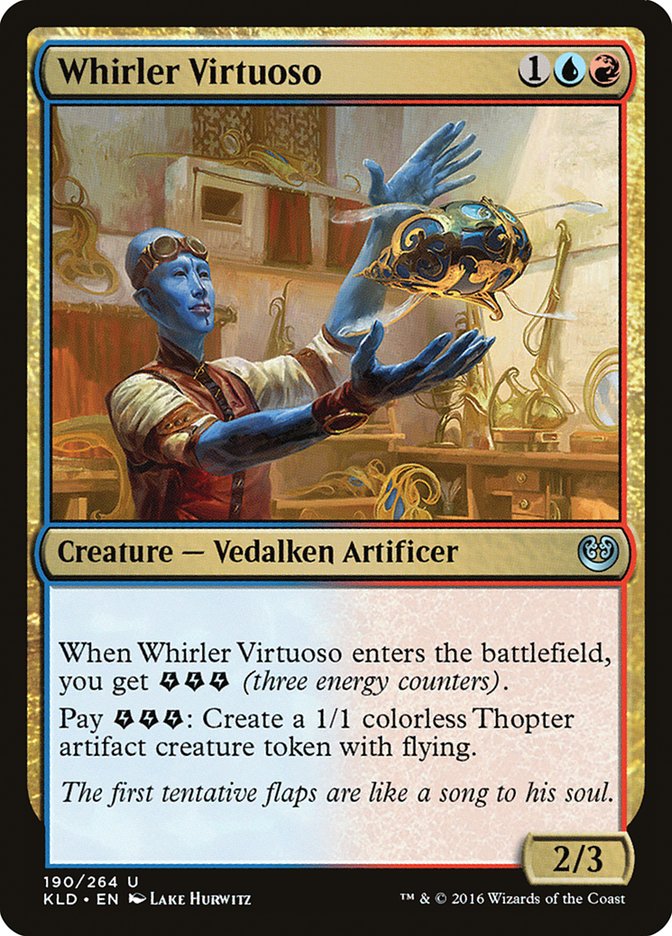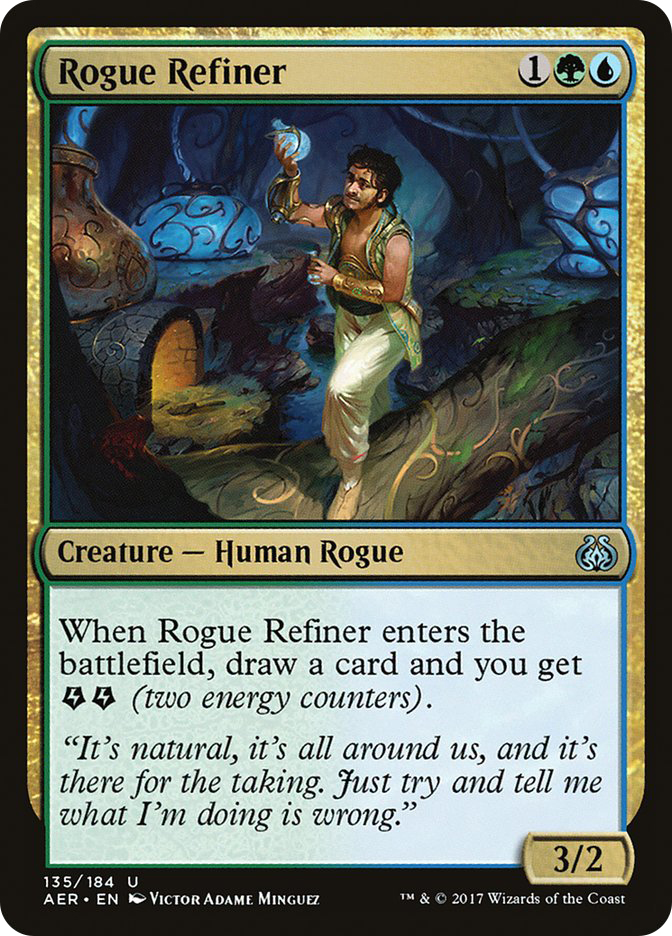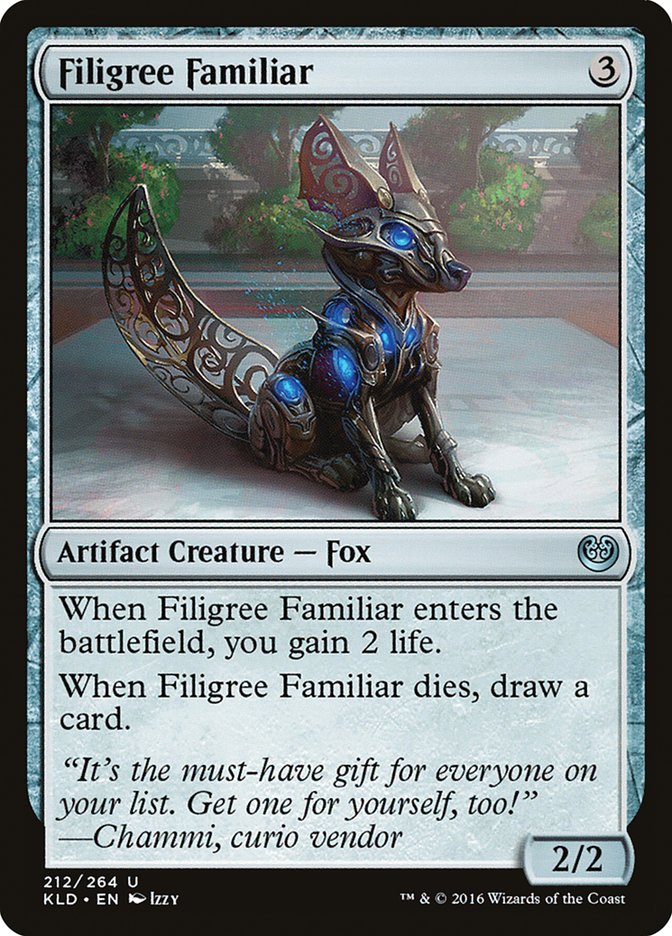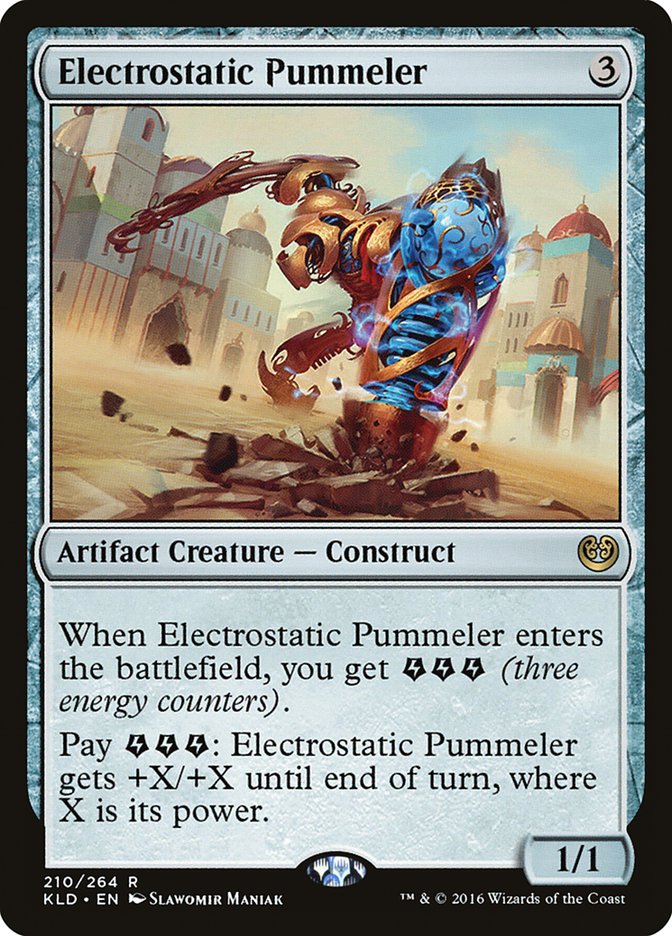A lot of sets these days have uncommon cycles of gold cards, and evaluating these cards can be tricky. The cycles are almost always designed for Limited, and when one of them happens to be strong enough for Constructed, it’s often mostly a coincidence (Reflector Mage is the poster child for this, as it was developed entirely for Limited and Wizards missed how strong it was in Standard, which led to its eventual banning).
Whirler Virtuoso ended up being a key card in the Aetherworks Marvel decks by the end of the last Standard season. Did Wizards of the Coast R&D spot it as an important Standard card? Who knows. It was certainly the key card in most U/R Draft decks, and I’m guessing making it fun to play in those decks was the priority.
The cards are all pushed for Limited. They’re supposed to be the cards that make you want to draft a particular color combination and give those decks some direction. They often serve to tell you what you should be doing with that color pair. If it’s your first draft and you don’t know that blue and black have a lot of shared artifact synergies, Contraband Kingpin tells you to look for artifacts.
Having a cycle of cards that are pushed (stronger than usual) for Limited (weaker than usual) results in cards that are all over the spectrum for Constructed. Some are clear misses, like Outland Boar, and others are clear hits, like Winding Constrictor. Others are trickier, like Maverick Thopterist, Renegade Rallier, and Rogue Refiner. Today, I’m positing that Rogue Refiner possibly hasn’t gotten the attention it deserves.
Filigree Familiar is a sweet card with great art that got a bit of hype when it was spoiled. People compared it to Kitchen Finks because it’s a three-mana creature that gains two life when it enters the battlefield and then generates additional value when it dies. Rogue Refiner is a much stronger card because it draws the card right away, which means both that you have the card now rather than later and that you definitely get the card. Also, it’s very easy to build a deck where two energy is generally better than two life, but even if you’re not using the energy at all, the extra power is almost as good as the two life, and once you factor in the difference in when you get the card, it’s stronger without the energy.
Filigree Familiar saw a tiny bit of play, but it’s not exactly the gold standard, and if I’m being totally (even remotely) honest in my evaluation, Rogue Refiner is a lot harder to cast, and people usually wanted Filigree Familiar specifically because it’s in artifact. Comparing this directly to Kitchen Finks, it’s the same size and draws a card instead of having a second life when it dies, and it gives you two energy instead of two life. Maybe that’s better, maybe worse; the context and goals of the cards are pretty different. The important point, really, is that we’ve never had better cost and stats on a creature that draws a card when it enters the battlefield, so the energy is basically free, and the card might be solid without it.
First, let’s try to get the most out of the card by building some decks that use the energy. One idea that I’ve been kicking around since last season but never really sat down and built is a Dynavolt Tower control deck that incidentally plays Aetherworks Marvel as a fair, grindy card, likely with outs to randomly Emrakul, the Promised End people. Obviously Emrakul’s off the table, but the deck might not be.
Creatures (14)
Lands (22)
Spells (23)

This deck aims to play a fair, interactive game of Magic. You’re never slamming Aetherworks Marvel and spinning the wheel hoping to win the game; you’re just developing your energy and casting it in passing, and often using it in response to a spell to hope to hit Disallow or Torrential Gearhulk to Disallow. Is this better than just activating Dynavolt Tower? Well, if you have Dynavolt Tower on the battlefield and you hit Glimmer of Genius, you’ve spent two energy to scry two and draw two instead of spending five energy to deal three damage, so yes, I think in general, if you have the option, you’re looking to use Dynavolt Tower primarily as an energy creator and Aetherworks Marvel as an energy sink, but each can fill both roles, of course.
This is definitely a midrange control deck. You’ll usually have a battlefield presence, since you have fourteen creatures and Dynavolt Tower kind of plays like a creature/planeswalker. You do potentially have a game-ending trump, but that’s incidental. What you really have is just a value-laden mix of threats and answers.
Another option is to go even fairer, and just build a creature-based energy beatdown deck:
Creatures (26)
- 4 Spell Queller
- 4 Longtusk Cub
- 2 Bristling Hydra
- 4 Whirler Virtuoso
- 4 Servant of the Conduit
- 4 Aethergeode Miner
- 4 Rogue Refiner
Lands (21)
Spells (13)

The idea here is similar to any other energy aggro deck: you build up energy incidentally throughout the early-game, and then when you stick an energy sink, it’s a lot better than it would normally be. Aethergeode Miner in particular is a nightmare for removal-based control decks. As long as you generate two energy before you cast it, it protects itself from removal, and then it builds up your energy reserves every turn, making your eventual Longtusk Cub, Bristling Hydra, or Whirler Virtuoso too much to deal with.
This deck has a lot of cards that make energy and don’t spend it: Attune with Aether, Rogue Refiner, and often Aethersphere Harvester. Combining those with the energy-generating potential of Longtusk Cub and Aethergeode Miner makes it very easy to accumulate large energy reserves.
One very similar but slightly less fair approach is to add Electostatic Pummeler. I didn’t want to fill my deck with pump spells, so I left it out, but it’s possible that you just need the explosiveness of the Pummeler, and it’s possible that it’s good even without adding any pump spells. It’s also worth noting that we now have a better Larger Than Life than we can play in addition or instead: Invigorated Rampage.
Here’s a version that tries to fall somewhere between the energy value deck and a dedicated Pummeler deck, looking to have the strengths of both:
Creatures (22)
- 2 Spell Queller
- 4 Longtusk Cub
- 4 Electrostatic Pummeler
- 2 Whirler Virtuoso
- 2 Servant of the Conduit
- 4 Aethergeode Miner
- 4 Rogue Refiner
Lands (21)
Spells (17)
Sideboard

This version is still trying to maximize its energy generation so that a Pummeler can win with minimal assistance, but it’s a lot better at stealing a game quickly, which may be necessary in a Standard format where your opponent can kill you out of nowhere at any time with an arbitrarily large number of Cat Beasts.
Speaking of which, one of the best ways to effortlessly slot the Saheeli Rai / Felidar Guardian combo into a deck is to make both cards as good as possible, maximizing the number of cards you have that are independently beneficial to Flicker, which makes Felidar Guardian play like a real card. Honestly, if Felidar Guardian draws a card when it enters the battlefield, even if you don’t draw Saheeli, that’s an actively good card. By itself, a 1/4 for four that draws a card is just a little too weak for Standard, but if you factor in the amount of respect it commands, that your opponent likely views it as a 1/4 that they have to kill or leave mana up for in addition to having drawn a card, then it’s just a good rate by itself.
This combo is so easy to slot into any deck that we can even just put it into this energy deck instead of the Pummeler combo, and it fills a very similar role:
Creatures (20)
Planeswalkers (4)
Lands (21)
Spells (15)

Oath of Nissa helps assemble the combo, and we move away from Aethergeode Miner because the incidental attacks don’t matter as much when we’re hoping to win the game with the combo. Longtusk Cub is largely a diversion, but it also offers a strong backup plan against people who are prepared to stop us from comboing.
Another option is to get more serious about Aetherworks Marvel and try to cast Ulamog, the Ceaseless Hunger with the help of Inspiring Statuary:
Creatures (16)
Lands (19)
Spells (25)
- 4 Aetherworks Marvel
- 4 Woodweaver's Puzzleknot
- 2 Harnessed Lightning
- 4 Glassblower's Puzzleknot
- 4 Attune with Aether
- 4 Renegade Map
- 3 Inspiring Statuary
Sideboard

Okay, so this one ended up in a spot where I don’t think it really wanted Rogue Refiner, so it’s a little off-topic, but it’s a pretty sweet direction for Aetherworks Marvel. In addition to a normal curve that allows you to activate Aetherworks Marvel on turn 4 and hit an Eldrazi, this deck has a backup nut draw of turn 1 Renegade Map, turn 2 Puzzleknot, turn 3 Inspiring Statuary, turn 4 World Breaker.
If you have two Woodweaver’s Puzzleknots, Inspiring Statuary, and Whirler Virtuoso, you only need four lands to cast Ulamog, the Ceaseless Hunger. That’s a very specific combination of cards, and you can’t have all of them on the battlefield on turn 4, but the point is to offer a rough frame of reference for what kind of battlefield you’re looking for to cast Ulamog with Inspiring Statuary, and the answer is that I’d guess it’s pretty realistic on turn 5 with a Whirler Virtuoso or turn 6 without in this deck, and remember that if you’re missing with Aetherworks Marvel, you’re still working toward a build that casts Ulamog now.
While it’s unclear exactly which mechanics will end up being able to compete with the best cards in Standard, I find it useful early on in a format, before we have real data to show what the best decks are, to develop a working knowledge bank of possibilities that the mechanics allow for when pushed to their extremes. This lets us know what tools are available once the targets of a format are clearly identifiable. I don’t imagine these decks to be the defining decks of the format, but they help flesh out the possibility space to consider when trying to figure out the best ways to attack the decks that come out on top early on.






